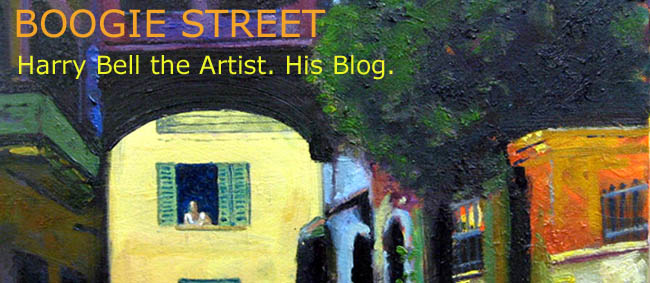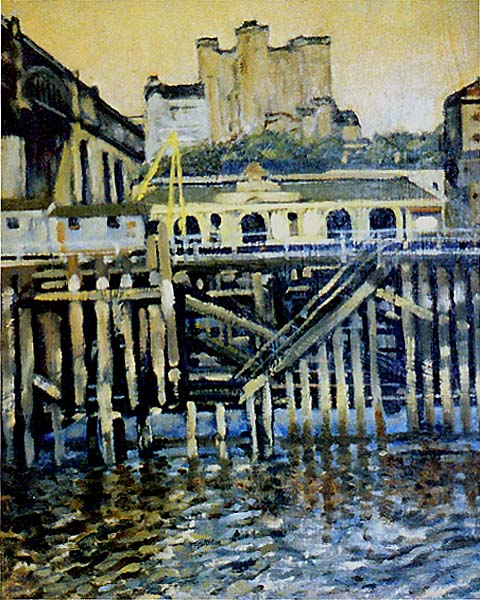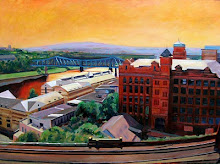Thursday, 29 August 2013
Newcastle Keep
Newcastle Keep from the River
(Oil on board, dimensions n/a) SOLD
I've been a little hampered in my posting of late, because I needed to get a new scanner and load Photoshop onto the new computer. All done now and a kind of normality seems to have returned to that part of my life, at least.
This painting is one of those I mentioned selling a short while ago. I had a photograph but needed a scanner to upload it. I did the painting at university as an experiment, using a very limited palette I'd found in a book by Chip Chadbourn - yellow ochre, burnt sienna and ultramarine, with white.
I was always quite fond of it, especially in the way I'd handled the water, so it was good when someone poking about in the studio came across it and liked it.
Labels:
Alfred Chadbourn,
Newcastle,
palette,
Photoshop,
sales
Monday, 26 August 2013
Erased Canvas
Sixty years ago, the American artist Robert Rauschenberg obtained a drawing from another US artist, Willem de Kooning and proceeded to erase it. The result, titled "Erased de Kooning Drawing, Robert Rauschenberg, 1953" is in the collection of the San Francisco Museum of Modern Art.
Leaving aside the merits or otherwise of this piece of work, I was reminded of it when today I embarked on a similar project.
Of the larger canvases I brought home from University in 2001, one was four by four feet, stretched and primed and pristine white. Too big to store easily in the studio downstairs, it's been tucked behind another similarly-sized completed painting in my bedroom. But there's no room for such a picture, devoid of imagery or no, in my next studio, so today I began the process of taking the blank one apart.
First of all the canvas had to be pulled away from the stretcher, the staples popping out and falling to the floor. Using my Gran's dressmaker's shears, I cut the canvas into strips and put them in the bin. Next I took out the screws. This showed that the bloke I bought it from ( he'd made several and didn't need two of them) had cunningly made use of several short lengths of wood, fastening them together with four-hole metal joining strips. So, more holes and more screws.
Once the screws were out, the stretcher still held together because of the thin strips of MDF round the edge which provide the canvas with lift away from the wooden stretcher. They had to be eased off with the screwdriver. Once everything was apart and on the floor, it looked a little like a flat-pack item from IKEA, laid out to check against the sheet of assembly diagrams. But I was going backwards, and the wood was broken up into shorter lengths and binned.
OK, I don't think this was an artwork, though I'm sure a video of the afternoon's work would entrance just as many people as those I see being ignored so often in galleries. And as a philosophical exercise, it kept me on track to shake off the ridiculous idea that possessions make me who I am.
Leaving aside the merits or otherwise of this piece of work, I was reminded of it when today I embarked on a similar project.
Of the larger canvases I brought home from University in 2001, one was four by four feet, stretched and primed and pristine white. Too big to store easily in the studio downstairs, it's been tucked behind another similarly-sized completed painting in my bedroom. But there's no room for such a picture, devoid of imagery or no, in my next studio, so today I began the process of taking the blank one apart.
First of all the canvas had to be pulled away from the stretcher, the staples popping out and falling to the floor. Using my Gran's dressmaker's shears, I cut the canvas into strips and put them in the bin. Next I took out the screws. This showed that the bloke I bought it from ( he'd made several and didn't need two of them) had cunningly made use of several short lengths of wood, fastening them together with four-hole metal joining strips. So, more holes and more screws.
Once the screws were out, the stretcher still held together because of the thin strips of MDF round the edge which provide the canvas with lift away from the wooden stretcher. They had to be eased off with the screwdriver. Once everything was apart and on the floor, it looked a little like a flat-pack item from IKEA, laid out to check against the sheet of assembly diagrams. But I was going backwards, and the wood was broken up into shorter lengths and binned.
OK, I don't think this was an artwork, though I'm sure a video of the afternoon's work would entrance just as many people as those I see being ignored so often in galleries. And as a philosophical exercise, it kept me on track to shake off the ridiculous idea that possessions make me who I am.
Thursday, 15 August 2013
Paintings at Cragside
Lord Armstrong, the man behind the construction of Cragside, died without an heir and his estate passed to his great nephew. In the tradition of undeserving inheritors, he quickly spent much of the fortune and to pay his bills many of the prime artworks in the family collection, including paintings by Millais, Turner, Wilkie and Leighton, were sold in 1910.
The collection is therefore now sadly depleted, but there's a good Turner and this painting which I particularly liked.
Wednesday, 7 August 2013
Cragside Wall Tiles
This is a view of Cragside from the gardens below:
Some of the corridor walls at the house were covered in rather splendid ceramic tiles. Here's a selection.
Some of the corridor walls at the house were covered in rather splendid ceramic tiles. Here's a selection.
Tuesday, 6 August 2013
William Morris at Cragside
It's some years since I was last at Cragside, the house and estate built by Lord Armstrong in the 19th century. Now owned by the National Trust, the house is a fascinating place to visit, full of labour-saving devices invented by Armstrong himself, including a hydraulic lift, automatically-turned spits, and the Library which was the first room in the world to be lit by Joseph Swan’s newly invented filament light bulbs.
With our good friends Roy and Kathleen, Pat and I went to Cragside last week. The weather was excellent, the food in the Visitor Centre well made and delicious and the walk round the house made more interesting by the helpful attendants.
In one of the rooms, on either side of the chimney breast, are these four stained glass windows designed by William Morris.
With our good friends Roy and Kathleen, Pat and I went to Cragside last week. The weather was excellent, the food in the Visitor Centre well made and delicious and the walk round the house made more interesting by the helpful attendants.
In one of the rooms, on either side of the chimney breast, are these four stained glass windows designed by William Morris.
Saturday, 3 August 2013
Sun Insurance Building
Sun Insurance Building, Newcastle (Oil on board, 12 x 24 ins)
SOLD
An interesting week, about which I may have more to say in the coming days, but notable in part for some sales of paintings. This is one of them.
The painting shows the top of one of Newcastle's fine buildings, built originally for Sun Insurance, although they no longer have offices there. The work dates from a period when I was very interested in looking up at the tops of buildings, something that few people do, and is a kind of companion to this one (owned by the same purchaser):
Bigg Market Buildings (Oil on board, 5 x 7 ins)
Private Collection
Subscribe to:
Comments (Atom)
























